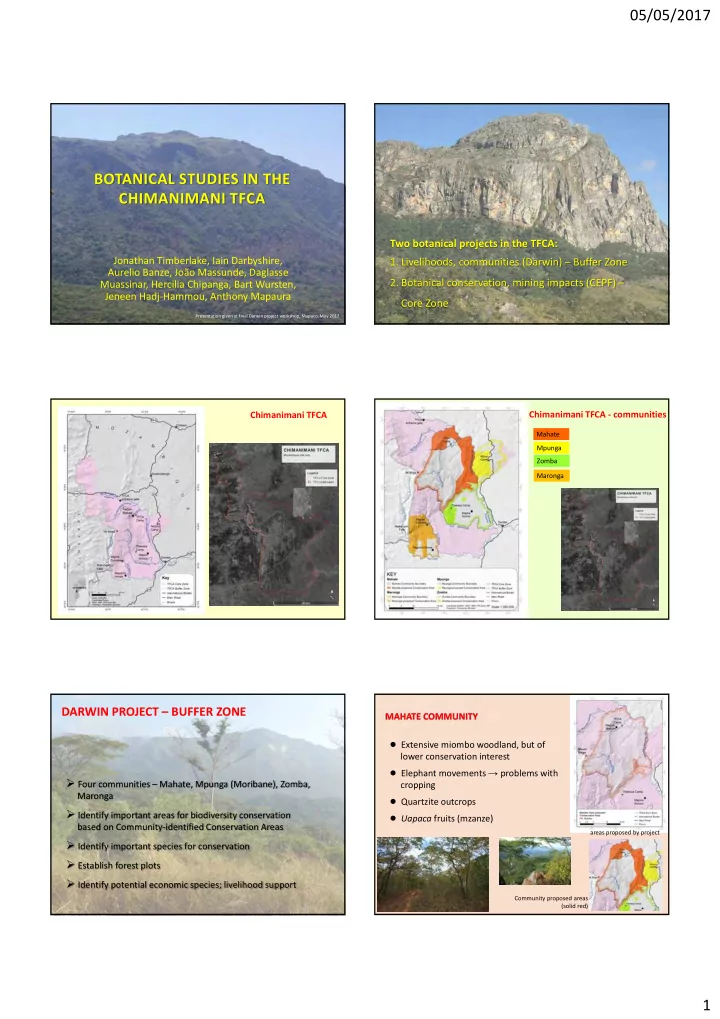

05/05/2017 BOTANICAL STUDIES IN THE CHIMANIMANI TFCA Two botanical projects in the TFCA: Jonathan Timberlake, Iain Darbyshire, 1. Livelihoods, communities (Darwin) – Buffer Zone Aurelio Banze, João Massunde, Daglasse 2. Botanical conservation, mining impacts (CEPF) – Muassinar, Hercilia Chipanga, Bart Wursten, Jeneen Hadj-Hammou, Anthony Mapaura Core Zone Presentation given at final Darwin project workshop, Maputo, May 2017 Chimanimani TFCA Chimanimani TFCA - communities Mahate Mpunga Zomba Maronga DARWIN PROJECT – BUFFER ZONE MAHATE COMMUNITY ● Extensive miombo woodland, but of lower conservation interest ● Elephant movements → problems with Four communities – Mahate, Mpunga (Moribane), Zomba, cropping Maronga ● Quartzite outcrops Identify important areas for biodiversity conservation ● Uapaca fruits (mzanze) based on Community-identified Conservation Areas areas proposed by project Identify important species for conservation Establish forest plots Identify potential economic species; livelihood support Community proposed areas (solid red) 1
05/05/2017 MPUNGA COMMUNITY ZOMBA COMMUNITY ● Extensive semi-deciduous / evergreen ● Semi-deciduous / evergreen forest, forest extension of TFCA Core Zone ● Swamp grassland (Rio Tave) ● Papyrus & Pandanus swamp ● Elephant movements → problems with ● Riverine forest / Pandanus cropping ● Papyrus for mats ● Bee fences ● Established ecotourism (Ndzou Camp) areas proposed by project areas proposed by project ● Funtumia for paper Community proposed areas Community proposed areas (solid yellow) (solid green) Conservation areas proposed by MARONGA COMMUNITY project (solid areas) in TFCA Buffer Zone ● Extensive semi-deciduous / evergreen forest; good condition ● Moist grassland ● Riverine forest ● Quartzite outcrops (Chimanimani Mtn endemics) ● Extension of TFCA Core Zone areas proposed by project ● Restricted forest species, including some endemics Community proposed areas (solid orange) Proposed Conservation Areas – community & project TFCA BUFFER ZONE area (km 2 ) Mpunga total community area 160 community-proposed conservation area 66.5 proposed forest area for conservation (project) 48.6 proposed Rio Tave area for conservation (project) 0.15 Mahate total community area 504 Community conservation areas are mostly areas not already community-proposed conservation area (incl. TFCA Core) 187 used for settlement or cultivation proposed area for conservation (project) 8.16 Zomba Most are adjacent to TFCA Core Zone total community area 230 community-proposed conservation area (incl. TFCA Core) 36.2 + 2.19 But how to effectively conserve them? Thekeza forest area proposed for conservation (project) 25.1 Mapira swamp area proposed for conservation (project) 0.43 Zomba forest area proposed for conservation (project) 1.73 Problem with recognition on ground of Core Zone boundary Zomba swamp area proposed for conservation (project) 2.18 Maronga Monitoring and regulation of field clearance and burning total community area 179 community-proposed conservation area (incl. TFCA Core) 129 For ecotourism, problem of access (except Mpunga) proposed area for conservation (project) 40.7 2
05/05/2017 INVASIVE SPECIES SPECIES WITH ECONOMIC POTENTIAL • Uapaca kirkiana – edible fruits Vernonanthura phosphorica • Cyperus papyrus – stems for mats • introduced by NGO for bee fodder • Funtumia africana – plumed seeds for paper • dense stands • Coffea salvatrix – speciality coffee • supresses forest regeneration • readily burns • Khaya anthotheca – artisanal folding chairs • spreads by wind • Funtumia / Harungana – kitchen utensils • also spreading in Core Zone at higher altitudes CEPF PROJECT – CORE ZONE ACTIVITIES • More a botanical study • Zimbabwe side known, but not Mozambique • Which habitats are most important • Three expeditions to north, centre and south • What is status of plant endemics • Focus above 1200 m altitude • What are threats resulting from gariemperos • Involvement of Kew, IIAM, Micaia, Harare • Comprehensive documentation of botanical diversity Herbarium, Meise (Belgium) of Chimanimani Mtns • Extensive plant collecting - 2014 & 2016 • Over 900 plant specimens collected MAIN FINDINGS • New studies realise 78 endemic taxa (8.5% of flora) • Found 9 taxa new to science • Total flora over 950 species • Most endemics found on quartzite, not schist soils • Importance of “rock gardens” • Mozambique and Zimbabwe sides very similar botanically • Ecological processes and flora basically in good condition 3
05/05/2017 GOLD-PANNING CONSERVATION • Gariempero activity is less now than before • Surprisingly, less impact on endemic plants than expected • Gariemperos havimg a big impact on rivers and streams (hydrology, aquatic animals), but not on grasslands • Severe loss of large mammal populations • Threats from frequent fires • Potential threat from alien invasive plant species • Carried out 66 IUCN Red List assessments on plants • 27 species threatened, 34 Least Concern Thanks to all participants on all five expeditions, Kew staff who identified specimens, and Micaia staff for logistical support. Projects were funded by the UK's Darwin Initiative and by CEPF under their Eastern Afromontane Ecosystem programme 4
Recommend
More recommend